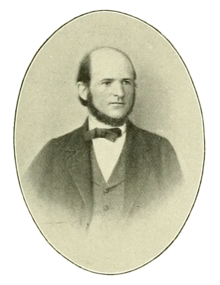Hermann Hoffmann (botanist)
Heinrich Karl Hermann Hoffmann (born April 22, 1819 in Rödelheim , † October 26, 1891 in Gießen ) was a German botanist . Its official botanical author's abbreviation is " H. Hoffm. "
Live and act
Hoffmann studied medicine in Gießen and Berlin, completed his habilitation as a private lecturer in Gießen in 1842 and was professor of botany there from 1853.
He was primarily concerned with the biological conditions of fungi and their relationship to fermentation, putrefaction and disease processes. In addition, he carried out long-term studies on the influence of climate and soil conditions on plant distribution and dealt with experimental investigations into the formation of varieties and the origin of related species. In later phases he promoted phenology in particular through detailed investigations. In 1874 he was elected a member of the Leopoldina .
In his book of 1869 he argues against Charles Darwin's theory of evolution , that is, variations as the basis for the formation of new species, and tries to test this theory experimentally (which is why the book was also known and owned by Darwin himself). The book is also one of the few contemporary works that mention Gregor Mendel's crossbreeding experiments. Hoffmann had carefully studied Mendel's 1865 essay, but he missed the essential new findings of Mendel. He only gives the following view of Mendel: Hybrids have the tendency to strike back into the parent species in the following generations . Hoffmann then mainly presents his own crossbreeding experiments (also on peas). In later works he no longer mentions Mendel.
Hermann Hoffmann's publications include the following:
- Description of the German plant families from the botanical-descriptive u. physiological-chemical standpoint (Giessen 1846);
- Investigations into the sleep of plants (Gießen 1851);
- Plant dispersal and migration (Darmstadt 1852);
- Weather and growth, or basic features of the plant climate (Leipzig 1857);
- Botany textbook (Darmstadt 1857);
- Icones analyticae fungorum. Illustrations and descriptions of mushrooms with special consideration of anatomy and evolutionary history (Gießen 1861–65, 4 booklets with 24 plates);
- Index fungorum (Leipzig 1863);
- Investigations to determine the value of species and variety (Gießen 1869); Archives
- Mycological reports (1870–73, 3 parts);
- Supplements to the flora of the Middle Rhine area (1879–89, 8 parts);
- Results of the most important plant phenological observations in Europe . (1885).
literature
- Ernst Wunschmann: Hoffmann, Hermann . In: Allgemeine Deutsche Biographie (ADB). Volume 50, Duncker & Humblot, Leipzig 1905, pp. 412-416.
- Dietrich von Denffer: Hoffmann, Hermann. In: New German Biography (NDB). Volume 9, Duncker & Humblot, Berlin 1972, ISBN 3-428-00190-7 , p. 424 f. ( Digitized version ).
Web links
- Author entry and list of the described plant names for Hermann Hoffmann (botanist) at the IPNI
Individual evidence
- ↑ Milo Keynes, The Introduction of Mendelism in Human Genetics, in: Milo Keynes, AFW Edwards, Robert Peel, A Century of Mendelism in Human Genetics, CRC Press 2004, p. 5
- ↑ Hoffmann, Investigations for the Determination of the Value of Species and Varieties, 1869, p. 136
- ↑ Michael Mielewczik, Darrel Francis, Bruno Studer, Michael Simunek, Uwe Hossfeld: The Reception of Gregor Mendel's Hybridization Attempts in the 19th Century - A Bio-Bibliographical Study, Nova Acta Leopoldina, NF, No. 413, 2017, pp. 83-134 , here p. 106
| personal data | |
|---|---|
| SURNAME | Hoffmann, Hermann |
| ALTERNATIVE NAMES | Hoffmann, Heinrich Karl Hermann (full name) |
| BRIEF DESCRIPTION | German botanist |
| DATE OF BIRTH | April 22, 1819 |
| PLACE OF BIRTH | Rödelheim |
| DATE OF DEATH | October 26, 1891 |
| Place of death | to water |
